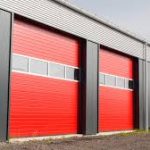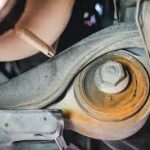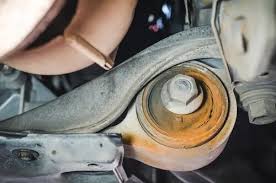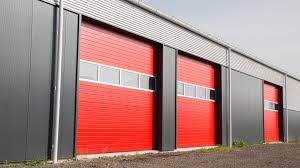Worn vehicle bushings can lead to various issues, from uncomfortable rides to safety concerns. According to automotive experts Polybush who specialise in car and van suspension bushes, common signs of failing bushings include uneven tire wear, vibrations or shaking while driving, clunking noises, and poor handling or steering response.
Uneven Tire Wear Patterns
Uneven tire wear patterns are often a telltale sign of suspension issues, particularly problems with control arm bushings. When these bushings deteriorate, they can cause the control arms to move excessively, resulting in uneven pressure distribution on the tires. This uneven wear typically manifests in specific patterns that can help diagnose the underlying problem:
• Camber wear: If the inside or outside edge of the tire wears more quickly than the rest, it may indicate worn control arm bushings affecting the wheel’s camber angle.
• Feathering: This pattern appears as smooth wear on one side of the tread ribs and sharp wear on the other, often caused by misalignment due to worn bushings.
• Cupping or scalloping: Characterized by diagonal scalloped dips across the tread, this wear pattern can result from worn shock absorbers or bushings allowing excessive wheel bounce.
• Toe wear: Excessive wear on both outer or inner edges of the tire can indicate toe misalignment, which may be caused by worn control arm bushings affecting the wheel’s positioning.
It’s important to note that uneven tire wear can also be caused by other factors, such as improper inflation, alignment issues, or worn suspension components. For instance, faulty springs can lead to uneven weight distribution, causing accelerated wear on certain areas of the tire.
In some cases, the uneven wear may be more pronounced on one side of the vehicle. For example, a driver reported that their 1996 Jaguar XJS Convertible experienced significantly more wear on the outer edge of the driver’s side tire. This asymmetrical wear pattern could indicate a specific problem with the suspension on that side of the vehicle.
Regular tire inspections are crucial for catching these wear patterns early. If you notice any unusual or uneven wear on your tires, it’s essential to have your vehicle inspected by a qualified mechanic. Timely diagnosis and repair of worn control arm bushings or other suspension components can prevent further tire damage, improve handling, and ensure your safety on the road.
Clunking Sounds in Suspension
Clunking sounds in a vehicle’s suspension system are often indicators of worn or damaged components that require attention. These noises typically occur when driving over bumps, potholes, or uneven surfaces, and can point to several potential issues within the suspension system.
One common cause of clunking sounds is worn or damaged control arm bushings. These bushings connect the control arms to the vehicle’s frame and help absorb road vibrations. When they deteriorate, they can allow excessive movement, resulting in a distinctive clunking noise. Similarly, worn ball joints, which connect the control arms to the steering knuckles, can produce clunking sounds as the suspension moves up and down over road irregularities.
Damaged or worn leaf spring shackles, found in trucks, vans, and SUVs, can also contribute to clunking noises. If these components bend or break, they may produce a clunking sound, typically originating from one end of the leaf spring shackle.
The sway bar system is another potential source of clunking noises. Worn sway bar links or bushings can cause the metal components to knock against each other, creating a noticeable clunking sound. Additionally, loose or damaged struts can lead to clunking noises, especially if the strut housing is dented, causing the shock to pop in and out of the strut tube.
In some cases, clunking noises may be attributed to more severe issues, such as a damaged panhard rod in older rear-wheel-drive vehicles. This component runs diagonally from the chassis to one side of the axle housing, and worn bushings in this rod can be a likely source of clunking.
It’s important to note that while these sounds may seem minor, they often indicate underlying issues that can affect vehicle safety and performance. For instance, worn suspension components can lead to poor handling, uneven tire wear, and reduced stability. Therefore, if you hear persistent clunking noises from your vehicle’s suspension, it’s advisable to have it inspected by a qualified mechanic to identify and address the root cause promptly.
Shaky Steering While Driving
Shaky steering while driving is a common issue that can be both unsettling and potentially dangerous. This problem often manifests as vibrations in the steering wheel, particularly at higher speeds. While there are several potential causes, three main culprits are frequently responsible for this phenomenon.
Unbalanced tires are the most common cause of a shaky steering wheel. This issue typically becomes noticeable at speeds around 50 miles per hour or higher. Unbalanced tires occur when the weight distribution of the tire and wheel assembly is uneven, causing vibrations that travel through the vehicle’s frame to the steering wheel. Regular tire rotations and balancing can help prevent this issue.
Brake rotor problems can also lead to steering wheel vibrations, especially when applying the brakes. Warped or unevenly worn rotors can cause pulsations in the brake pedal and steering wheel. This issue is often more noticeable during braking but can persist even when not actively slowing down.
Worn suspension components, particularly control arm bushings, can contribute to steering wheel shake. These bushings are designed to absorb road vibrations and maintain proper wheel alignment. When they wear out, they can affect the car’s handling and cause steering response to become sluggish. In some cases, replacing control arm bushings can resolve persistent vibration issues that tire balancing alone cannot fix.
It’s worth noting that the severity and nature of the shaking can provide clues about its cause. For instance, if the shaking is most pronounced between 55 and 75 mph, it’s likely due to unbalanced tires. However, if the vibration occurs at various speeds or is accompanied by other symptoms like uneven tire wear or clunking noises, it could indicate more serious suspension problems.
In rare cases, a shaky steering wheel might be caused by an imbalanced driveshaft, particularly in rear-wheel or four-wheel drive vehicles. This issue can create vibrations that are felt through the entire vehicle, not just the steering wheel.
If you experience persistent steering wheel shake, it’s crucial to have your vehicle inspected by a qualified mechanic. Ignoring the problem can lead to accelerated wear on other components and potentially compromise your safety on the road. Regular maintenance, including tire rotations, balancing, and suspension checks, can help prevent many of these issues and ensure a smooth, stable driving experience.
Loose Ball Joint Symptoms
Loose ball joints can significantly impact a vehicle’s performance and safety. Recognizing the symptoms early is crucial for timely repairs and maintaining optimal driving conditions. Here are some key indicators of loose ball joints:
• Clunking or knocking noises are often the first and most noticeable signs of a failing ball joint. These sounds typically occur when driving over bumps, potholes, or uneven surfaces. The noise is caused by the worn ball joint rattling in its socket, creating a distinct metallic clunk that becomes more pronounced as the joint deteriorates.
• Uneven tire wear is another telltale sign of loose ball joints. As the joint wears, it can cause misalignment of the wheel, leading to accelerated and uneven tire wear. This often manifests as excessive wear on the inside or outside edge of the tire, or in irregular patches across the tire’s surface. If you notice one front tire wearing out more rapidly than the other, it could indicate a problem with the ball joint on that side.
• Steering issues are common with loose ball joints. Drivers may experience a loose, wandering feeling in the steering wheel, making it difficult to maintain a straight line. This symptom is particularly noticeable when making turns or driving at higher speeds. In severe cases, the steering may feel disconnected from the wheels, significantly compromising vehicle control.
• Vibrations in the steering wheel or throughout the vehicle cabin can also indicate loose ball joints. These vibrations are often more pronounced at higher speeds or when driving over rough terrain. As the ball joint deteriorates, it allows for more play in the suspension, which can translate into noticeable shaking or wobbling sensations.
• Visual inspection can reveal signs of ball joint wear. Look for damage to the rubber boot that protects the ball joint. If this boot is torn or damaged, it can lead to grease leakage and accelerated wear. In some cases, you may be able to see excessive movement in the joint itself when the wheel is jacked up off the ground.
• Alignment difficulties are another symptom of loose ball joints. Even if the alignment appears correct on an alignment machine, the effects of a loose ball joint can become apparent once the vehicle is on the road. This can manifest as difficulty maintaining proper wheel alignment, leading to handling issues and further tire wear.
It’s important to note that these symptoms can also be indicative of other suspension issues. Therefore, if you experience any of these signs, it’s crucial to have your vehicle inspected by a qualified mechanic. Ignoring loose ball joint symptoms can lead to more severe problems, including complete joint failure, which can cause loss of steering control and pose significant safety risks.
Cupping and Scalloping Causes
Tire cupping and scalloping are distinct wear patterns that can significantly impact vehicle performance and safety. These issues often stem from various suspension and alignment problems, with several key factors contributing to their development:
Misaligned wheels or warped rims are primary culprits in tire cupping. When tires are poorly aligned, they create uneven contact with the road, causing stress on the tread. This stress can lead to a scalloped wear pattern every few inches, typically around the inside edge of the tire. The misalignment affects the balance of driving pressure across the tire tread, resulting in uneven wear on the side of the treads rather than the optimized center tread contact.
Worn suspension components, particularly shocks and struts, play a crucial role in tire cupping. Over time, these parts wear out, causing wheels to bounce instead of rolling smoothly. This bouncing creates uneven points of pressure on tires, leading to cupping. The inability of worn shocks and struts to absorb road imperfections effectively causes the tire to lose consistent contact with the road surface, exacerbating the cupping effect.
Unbalanced tires or bent wheels can also contribute to cupping. The centrifugal forces involved in spinning an unbalanced wheel can cause the tire to bounce slightly, leading to cupping over time. This imbalance results in uneven pressure distribution throughout the tread pattern, with some areas receiving more pressure and wearing prematurely.
The quality of tires themselves can influence the likelihood of cupping. Lower-quality tires made with inferior materials are more susceptible to cupping due to their reduced ability to maintain consistent road contact and withstand uneven pressures.
Worn control arm bushings can indirectly cause tire cupping by affecting the vehicle’s alignment. As these bushings deteriorate, they allow for excessive movement in the control arms, which can lead to constant changes in alignment during driving. This dynamic misalignment contributes to uneven tire wear, including cupping patterns.
It’s important to note that tire cupping is often a symptom of underlying vehicle issues rather than a standalone problem. Once cupping begins, it won’t correct itself, and addressing the root cause is essential. Regular maintenance, including proper wheel alignment, tire balancing, and timely replacement of worn suspension components, can help prevent cupping and scalloping, ensuring optimal tire performance and longevity.
Summary
Identifying bad vehicle bushings involves recognizing various symptoms including uneven tire wear patterns, suspension clunking, shaky steering, and loose ball joint indicators. These issues often manifest through specific patterns like tire cupping and scalloping, which can significantly impact vehicle performance and safety. Regular inspection and maintenance are crucial for preventing these problems, as addressing them early can prevent more severe damage to the vehicle’s suspension system and ensure optimal driving conditions.








